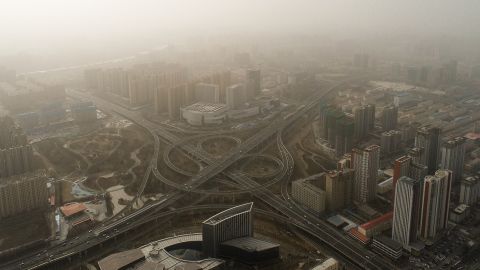Beijing and large swaths of northern China woke to choking sand and dust on Monday, as a winter sandstorm sent air pollution levels off the charts.
A thick cloud of dust blanketed the Chinese capital, where the air quality index of PM10 – particles of pollution that are less than 10 micrometers in diameter and can enter through the nose and travel to the lungs – hit 999, meaning it exceeded the top of the scale, far beyond the point deemed hazardous to health.
Concentrations of PM10 particles exceeded 561 micrograms per cubic meter by 8 a.m., according to Beijing’s environmental monitoring center. That figure is more than 10 times the daily average guideline of 45 micrograms per cubic meter set by the World Health Organization.
Beijing used to be hit by sandstorms regularly in the spring, but less so in the winter. The last time it saw a sandstorm so late in the year was in 2015.
The sandstorm originated in Mongolia and gradually moved south. Early on Monday morning, the Central Meteorological Observatory issued a blue alert for sandstorms – the lowest level in a four-tier warning system – for much of northern China, from the eastern city of Tianjin to Xinjiang region in the far west.
Mongolia, which lies north of mainland China, is experiencing strong cyclones, according to the meteorological administration. The sand and dust from Mongolia have moved east and south over China’s northern regions, carried by the cold high pressure at the back of the cyclones.
Sandstorms also hit northern Hebei and Shanxi provinces, western Gansu, and central and western Inner Mongolia on Monday, state-run news agency Xinhua said. Other parts of the country, including northern Xinjiang, are seeing high levels of wind gusts. The sandstorms are expected to last through Tuesday.

Sand and dust blanket the city of Hohhot in Inner Mongolia on Monday.CFOTO/Future Publishing/Getty Images
In the spring of 2021, Beijing was hit by the biggest sandstorm in nearly a decade, which turned the skies an eerie shade of orange. In previous decades, each May saw at least two rounds of sandstorms, according to Xinhua. The frequency and severity of sandstorms was partly due to drought, growing population pressure and poor progress in revegetation, which caused rapid desertification of land in the north and northwest.
But sandstorms have since decreased dramatically; the annual number of sandstorm-impacted days in Beijing fell from a peak of 26 in the 1950s to just three days after 2010, Xinhua reported.
Since 2000, the Chinese government has invested billions of dollars toward sandstorm prevention. Authorities have launched various reforestation and ecological projects, and installed satellites to monitor sandstorms and alert weather agencies ahead of time.
Source : CNN
















Add Comment